Average smartphone screen resolution. What diagonal is optimal for a smartphone screen?
For many of us, the key parameter when choosing a new smartphone is the screen – the face of the gadget. A dozen years ago, the presence of a color display was a characteristic of phones in the highest price range, but today this will not surprise anyone, and so many different technologies for creating color screens have appeared that you can’t immediately figure out which one is better. In addition, you need to take into account such characteristics as resolution, pixel density, and touchscreen type. How can an ordinary user understand all this?
Screen size and resolution
Over the past few years, there has been a trend towards increasing the diagonal size of smartphones. Today it's hard to find new smartphone with diagonal less than 4 inches, even models with diagonal 4.5-4.7 inches are not so widely represented, although The 4.7-inch diagonal can be called the most comfortable. Golden mean on at the moment can be called the diagonal in 5 inches, although until recently such gadgets were called shovel phones. With such dimensions, you can comfortably watch photos and videos, and the smartphone is even more or less comfortable to hold and operate with one hand.
Devices with a diagonal of 5.5 inches or more They are called phablets: they are great for watching movies and Internet pages, but they are not so comfortable in the hand, and they are difficult to fit into some pockets. But even this was not enough for manufacturing companies, and smartphones with a diagonal of 6 and even 6.5 inches. They're practically tablets! The demand for such models is not yet very high, so the choice is limited.
If the usability of a gadget depends on the size of the screen, then the quality of the picture depends on the resolution. Display resolution is reported as number of pixels vertically and horizontally, for example, 1280*720. The higher the resolution, the clearer the picture and the less visible its individual components. Low resolution produces a grainy image in which individual pixels can be easily seen. Today, smartphones are equipped with a screen with one of the following resolutions:
- 320*480 (HVGA) is rarely used and in the cheapest smartphones with no large diagonal;
- 480*800 (WVGA) is also rarely used, and a more or less normal image can only be obtained with a screen diagonal of 4 inches;
- 540*960 (qHD) found in budget models smartphones and with a diagonal of 4-4.5 inches allows you to get an image of acceptable quality;
- 720*1280 (HD) is the most common resolution today. Many mid-range smartphones are equipped with such screens. price category with a diagonal of 4.7-5.5 inches;
- 1080*1920 (Full HD) – resolution the highest level. Such a diagonal screen can reach 7 inches, and the image will be clear and grain-free;
- 2560*1440 (QHD), 3840*2160 (4K). Such permission is now received by the most expensive smartphones, and the picture on the screen really looks great.

It is worth noting that companyApple uses in his smartphones non-standard resolutions: 640*1136, 750*1334 etc. It was this manufacturer who introduced the concept retina display, focusing on pixel density as a key indicator of a smartphone display.
Pixel Density
Pixel density is defined as dpi: it is clear that at the same resolution, but different diagonals The screen density will be different, and this is important to take into account. Apple once stated that with a density of 300 pixels per inch, the human eye from a distance of 30 cm is not able to discern the individual components of a picture, perceiving the image as a whole. Therefore, the company does not use screens with a pixel density of more than 300 in its gadgets, since the perception will be the same, and the device will be more expensive.
Many other companies are proving that a person can distinguish individual points of an image even at higher pixel densities, offering screens with a density of 400 dpi. These displays look great, but in reality the difference is not that significant.
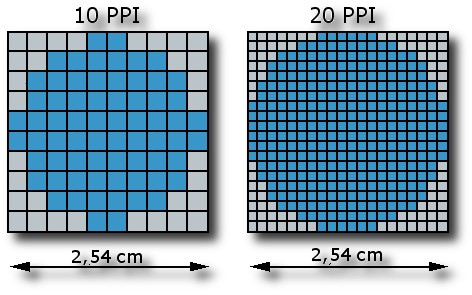
Practice shows that exactly to a density of 300 pixels/inch and it’s worth focusing on so that the smartphone is truly easy to use. It is impossible to indicate what the resolution should be, since this parameter also depends on the diagonal of the display: for 4.7 inches, the resolution can be 1280*720, and for a smartphone with a diagonal of 5.5 inches, to achieve the same picture quality you need screen with a resolution of 1920*1080.
However, you can normally use a smartphone whose screen pixel density is 250 or so, but if this figure below 200, then individual points will be very noticeable. When switching from using a smartphone with a higher resolution to a smaller one, you may feel discomfort for some time.
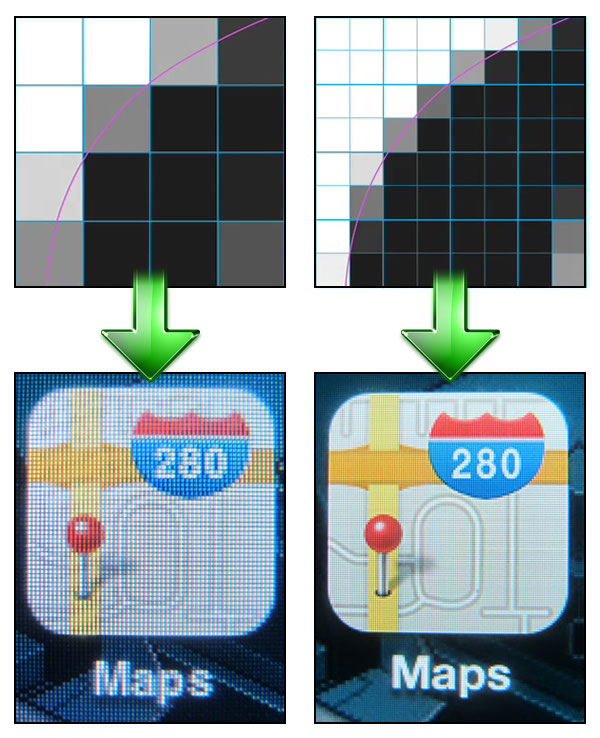
Screen manufacturing technology
All screens in smartphones today can be divided into two main types:LCD andOLED. Technologies have their own undeniable advantages and disadvantages. LCD displays require additional screen backlighting, while OLED displays are based on light-emitting diodes, so they do not need a backlight. This is the key difference that creates the difference in display performance.
LCD displays have become more widespread and are divided into several types:
- TN– one of the most widespread and budget technologies for the production of color displays. Today, such displays are used in the cheapest smartphones, since their production is quite inexpensive, but allows you to get a product of acceptable quality. Viewing angles and color rendition are not at the highest level;
- IPS-screens today are used in most smartphones of various price categories. After the significant shortcomings of the technology were eliminated in 2009, it received such wide recognition. Such screens are clear and contrasty, have natural color rendition, wide angles overview and quick response to pressing;
- V.A.– symbiosis of TN and IPS. Such screens produce a clear picture with accurate white and black colors, but when viewed from a certain angle, the colors are distorted;
- PLS- a screen created by Samsung with the intention of reducing the cost of IPS technology, but maintaining its main advantages. Such displays display about 98% of the colors that are displayed in IPS, but cost 20% less. The energy consumption of these screens is low, viewing angles are wide, color rendition is excellent, which is why they are actively used in Samsung products.
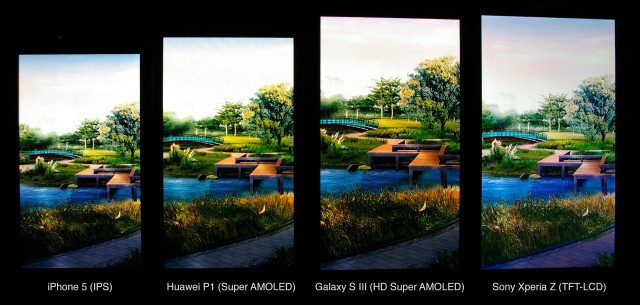
TO the main advantages of displays of this technology(with the exception of TN) can be attributed to accurate color reproduction and the presence of ideal white, which is difficult for OLED screens. The maximum brightness is much higher due to the display technology, which is important for the comfort of using the gadget in bright conditions. sunlight. Such displays practically do not change colors at different viewing angles, they are cheaper to produce than OLED technology screens, and the pixels in them do not fade over time.
OLED displays use light-emitting diodes for image formation and illumination. Due to this it is achieved faster response time, because one of the layers of the screen is missing. AMOLED screens appeared thanks to Samsung's work on improvement OLED technology, and the result was active matrix displays that allowed the user to provide the user with an image of amazing quality. Today, such screens are considered the most advanced, but the company has proposed an even more advanced type of screen - Super AMOLED , in which the touchscreen and the display surface are one whole. This allows you to reduce thickness, improve color rendition, increase brightness and increase viewing angles.
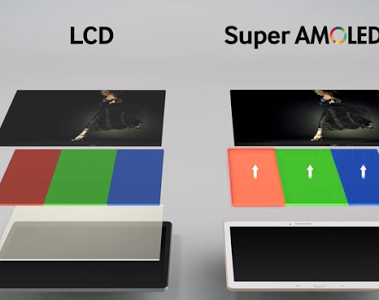
Main advantages technology is considered to have high contrast images. By the way, from poisonous flowers, for which they were once criticized Samsung smartphones, managed to quickly escape, and today AMOLED displays have become the standard in terms of contrast: 30,000:1 versus 1,500:1 for IPS. The black color in such displays is truly black, because the technology is designed in such a way that only those pixels that are necessary to create an image light up, the rest do not light up, thanks to which it is also possible to save the energy of the gadget. However, if images with white and light colors are used more often, then the cost-effectiveness is reduced to nothing. AMOLED displays are slightly thinner, which affects the thickness of the gadget, and for some, this factor is important when choosing a smartphone.
Touchscreen type
Touch screens today are represented by the following main types:
- resistive;
- capacitive.
Resistive screens They are inexpensive, so they are used in budget-class smartphones. Such displays were used in the first touchscreen smartphones. They consist of two layers, on the surface of each of which conductor tracks are applied. When you press the screen, the current resistance at a point with specific coordinates changes. A significant advantage of the technology is the ability to press on the screen with any object, but the display is not very durable, gets scratched and may lose brightness over time.
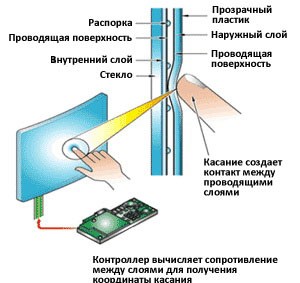
Capacitive screens Today they are used almost everywhere in smartphones. The technology is based on calculating the current leakage when pressing the display. The screen can consist only of glass with a conductive layer or of glass and film. It only reacts to finger touches, but is more resistant to scratches and has high brightness. Often such screens are closed protective glass and apply an oleophobic coating to them so that the display gets less dirty.

Manufacturers continue to increase smartphone screens. Relatively recently, a device with a 5" display was without hesitation classified as a tablet, such as the DELL Streak 5. Now it is standard size display for Android flagships. Moreover, we are talking about 2013 models; new smartphones will be released in 2014, and flagships may have displays measuring 5.5” or larger. And this will become the new standard for the whole year.
A new class of devices has emerged - phablets, which are difficult to classify as smartphones due to their huge screens. At the same time, some phablet models are very close to 7” tablets. Smartphones are getting bigger, and there are already people who don't like this trend. Indeed, not everyone wants to have a pocket device, for which you need to sew a special pocket. There are still people who think that 3.5” Steve Jobs defined as optimal, and they are. Although even in the most Apple has already they don't think so.
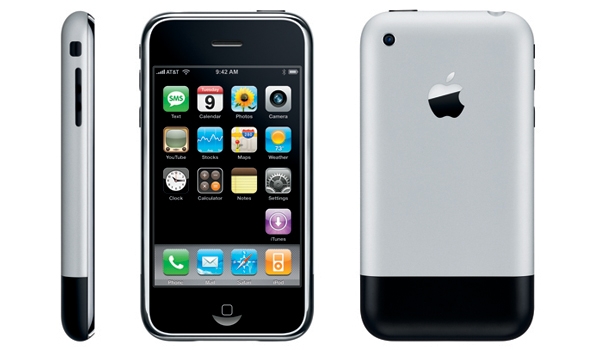
Indeed, what screen diagonal is considered optimal for a smartphone? It is very difficult to give a definite answer to this question. This is a very subjective point. However, even subjective preferences can be measured; for this there are statistics and various public opinion polls. Thus, the resource phonearena.com conducted a survey among users which display diagonal they prefer. The resource conducted such a survey for the first time back in 2011 and, as it turned out, over the past 3 years preferences have changed very much.
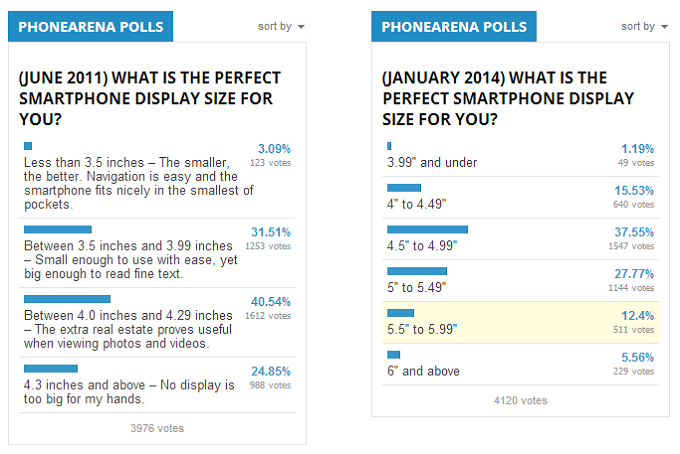
In 2011, 35% of users chose a diagonal of less than 3.99" as their ideal size. For 40.5% the best option there was a screen from 4" to 4.29". In 2014, only 1.19% voted for the option “less than 3.99”, and 15.53% voted for screens with a diagonal of 4”-4.49”. But a total of 65% voted for the option over 4.5”. Thus, for the majority the perception large smartphones has changed. Now even Galaxy Note doesn’t seem too big, and smartphones with 4” displays are generally perceived as small. Moreover, this trend also extends to tablets, for which a 10" diagonal is no longer the limit - according to rumors, Apple is preparing a device with a screen larger than 12", and Samsung has already announced a similar product.
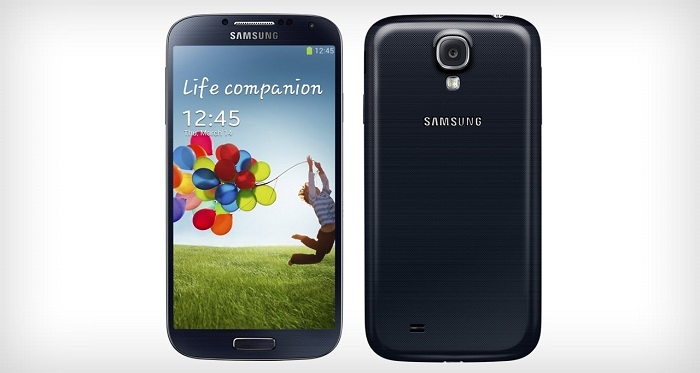
On the other hand, the day is not far when manufacturers will no longer be able to simply enlarge the screen in each new flagship. For handheld devices that the user will take with him every day, there are certain physical limits, which we have already come close to.
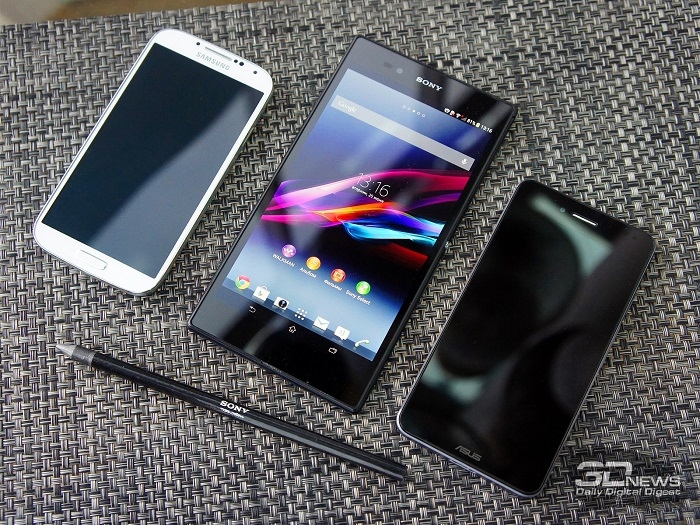
In 2014, a 5.5" diagonal will become the standard for smartphones. After this, you can increase the display by a maximum of another inch. After 6.5”, even despite the obvious transformation of users’ consciousness in recent years, devices will not be perceived as either pocket-sized or compact.
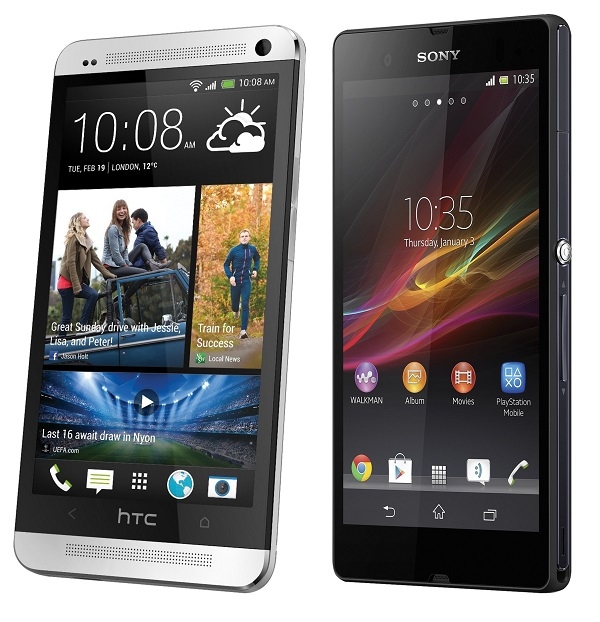
The next step, which will most likely be taken in 2015, is flexible folding displays. If the technology can be improved and smartphones can actually be folded or even rolled up, manufacturers will overcome the physical limitations on the size of a smartphone that can still be squeezed into a pocket.
Recently, rumors appeared on the Internet that in 2016 Apple, among other things, will introduce a compact smartphone with a 4'' screen diagonal, in the spirit of models from two years ago - bright times when Apple was not captured by the same ideas as other manufacturers . Later, a similar rumor appeared about new device from Meizu. It's like the Chinese are cooking a smaller version Meizu version Pro 5 with the “mini” prefix and a really small screen by modern standards – with a diagonal of 4.7’’ and maintaining the characteristics of the flagship, without compromise. Perhaps these are all just dreams, but it’s so nice to dream!
Dream that in 2016 manufacturers will calm down a little and move away from the principle “if it’s a flagship, then it’s a shovel!” Yes, this year there were quite a few good devices with a large screen diagonal. Even budget devices are already concentrated mainly in the 5-inch category, as if everyone had suddenly forgotten about more compact models. Meanwhile, if you pick up a smartphone with a diagonal of 4.2 - 4.7 inches, it turns out that it is very convenient! Of course, if you've been exclusively using Samsung's Note line of devices for the past three years, you're unlikely to miss compact smartphones. But sometimes I install the main SIM card in Meizu MX2 (4.4'') for one or two days or just pick up HTC HD2 (4.3'') and understand that the dimensions of these devices are comfortable for me even today, years after their entering the market.
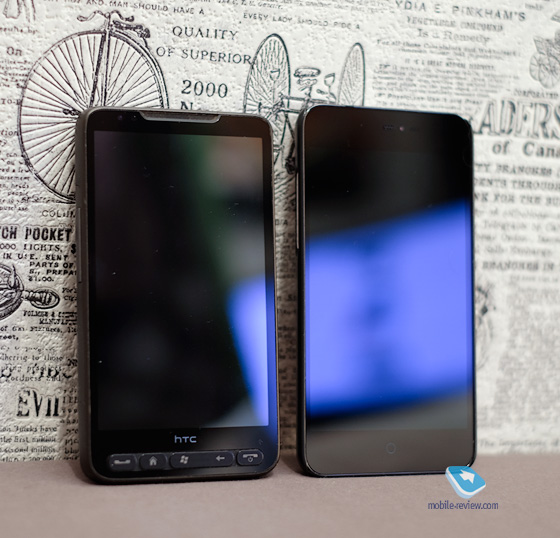
Using the MX2, I don't feel any problems or lack of screen real estate due to its compact size. Rather, it all comes down to outdated characteristics, so, of course, I cannot use such a device for more than a couple of days, just for the experiment. Outdated cameras, the interface, which is slow by modern standards, and other things make themselves felt. But the dimensions! They are damn comfortable and correct!
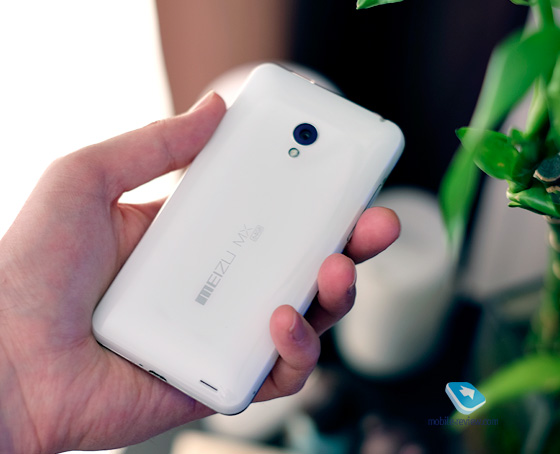
Holding the smartphone in one hand, I can easily reach almost every edge of the screen with the thumb of the same hand. At active use I don’t need to intercept the device or connect a second hand to poke at some interface element in the program or settings that is completely remote from the lower right area. The smartphone takes up little space in your pocket, finally. Yes, a device with a 4.4” diagonal will not protect the ear from gusts of wind, it cannot be used for digging, and it is probably not very suitable for watching videos at home in the evening while lying on the couch. But as a working tool, a smartphone with a diagonal of up to five inches, in my opinion, remains relevant and convenient.
What display size is considered the most popular? Chinese in lately presented a bunch of new smartphones with a screen size of 5.5 inches, but are such models in demand among users? Recently, these questions were raised in comments on the AliTrust website and the editors decided to conduct their own research to find out the truth.
European statistics
Let's start with world statistics, because the opinion of the world community is difficult to ignore. According to research by the Device Atlas organization, not all users like large-screen smartphones.
Statistics were collected in the following countries: Japan, Australia, India, USA, UK and Nigeria. Please note that this is not a survey; the data was taken from reports that collected information on traffic consumption. These reports usually contain information about operating system devices, browsers used and technical specifications gadgets, such as resolution and screen size.
Today, people most often buy devices with a 4.7-inch display. This is natural, because among the huge variety of mobile technology, gadgets lead by a huge margin Apple. At the same time Iphone time Available in two screen sizes - 4.7 inches and 5.5 inches. Apparently, the first model is more convenient for buyers.
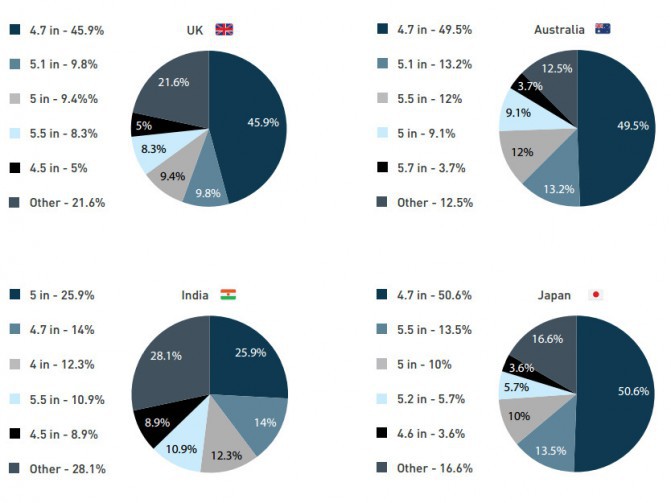
In second place mobile devices with a display size of 5 inches. On the third are 5.5-inch screens, which are especially revered by the Chinese, but relatively unloved by Europeans and users from other “advanced” countries.
Now let's look at screen resolutions. The first place is occupied by the standard 1334x750 pixels, which is indicative for the iPhone. It is followed by Full HD 1920x1080 pixels, after which comes the HD standard 1280x720 pixels.
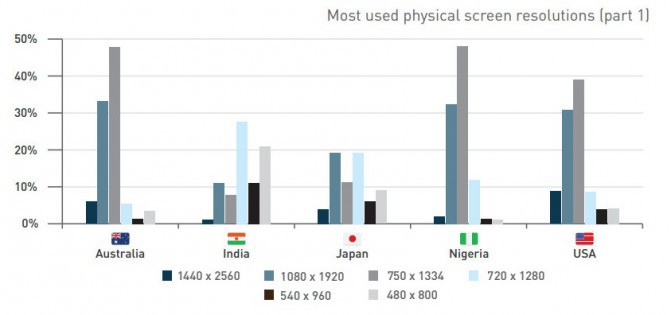
In order not to arouse a burning feeling of envy in readers, let us clarify that people still have a lot of outdated technology. Displays with a resolution of 480x800 pixels or 540x960 pixels do not surprise anyone. But there are relatively few ultra-modern gadgets with a resolution of 1440x2560 pixels, either due to their high cost, or because of the inconvenience of use - after all, such equipment has considerable dimensions and significant weight. Or maybe all three factors play a role.
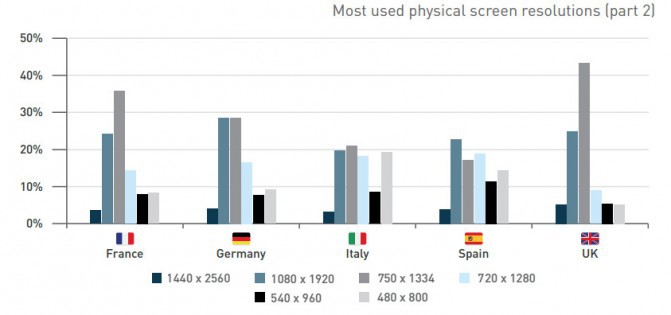
Russian statistics
America and Australia - of course, this is good, but we are interested in the opinion of Russian users. We did not conduct surveys on the streets, but published a post with anonymous voting V social network VKontakte. As expected, the results turned out to be different from the world ones. Since more than 4,700 people took part in the survey at the time of its completion, and target audience group includes both men and women of different ages (AliExpress buyers), the statistics can be considered reliable.

The most popular mobile technology among Russians is with a display size of 5-5.1 inches. This is explained by the fact that a lot of Chinese smartphones in connection with the successful entry into the market of AliExpress and others large online stores China.
iPhones are also in use here, although due to their price, such smartphones can be afforded by a limited number of people. Most often, Apple products are purchased in Moscow and other large cities of the Russian Federation, where the standard of living and salaries are higher than in the regions. However, other equipment also has a screen size of about 4.7 inches, for example, the Chinese model HTC One.
The third place in Russia is occupied by gadgets with a display size of 5.5 inches, and we have already described the reason for this - inconvenience of use. Such a “shovel,” especially in a case, is difficult to put in a pocket and uncomfortable to hold in your hands. But such smartphones are indispensable as an alternative to a tablet, which outweighs the above-mentioned disadvantages.
We invite you to give your answer in the comments, What is the most popular smartphone screen size today?. Write, we will discuss.